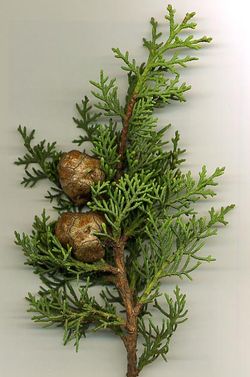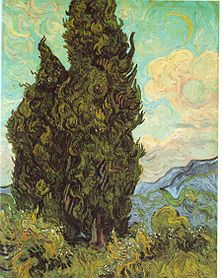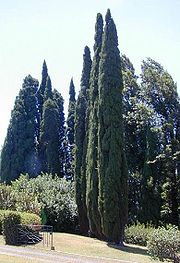BACK | HOME
Cupressus sempervirens
From Wikipedia, the free encyclopedia
| Mediterranean Cypress | |
|---|---|
 |
|
| Mediterranean Cypress foliage and cones | |
| Conservation status | |
| Scientific classification | |
| Kingdom: |
Plantae |
| Division: |
Pinophyta |
| Class: |
Pinopsida |
| Order: |
Pinales |
| Family: |
Cupressaceae |
| Genus: |
Cupressus |
| Species: |
C. sempervirens |
| Binomial name | |
|
Cupressus sempervirens L. |
|
Cupressus sempervirens, the Mediterranean Cypress (also known as Italian, Tuscan, or Graveyard Cypress, or Pencil Pine) is a species of cypress native to the eastern Mediterranean region, in northeast Libya, southeast Greece (Crete, Rhodes), southern Turkey, Cyprus, western Syria, Lebanon, Israel, Malta, Italy, western Jordan, and also a disjunct population inIran.
It is a medium-sized evergreen tree to 35 m (115 ft) tall, with a conic crown with level branches and variably loosely hanging branchlets[1]. It is very long-lived, with some trees reported to be over 1,000 years old.
The foliage grows in dense sprays, dark green in colour. The leaves are scale-like, 2-5 mm long, and produced on rounded (not flattened) shoots. The seed cones are ovoid or oblong, 25-40 mm long, with 10-14 scales, green at first, maturing brown about 20–24 months after pollination. The male cones are 3-5 mm long, and release pollen in late winter.
It is moderately susceptible to cypress canker, caused by the fungus Seridium cardinale, and can suffer extensive dieback where this disease is common.
The species name sempervirens comes from the Latin for 'evergreen'.
[edit]Uses
Mediterranean Cypress has been widely cultivated as an ornamental tree for millennia away from its native range, mainly throughout the central and western Mediterranean region, and in other areas with similar hot, dry summers and mild, rainy winters, including California, southwest South Africa and southern Australia. It can also be grown successfully in areas with cooler, moister summers, such as the British Isles, New Zealand and the Pacific Northwest (coastal Oregon, Washington and British Columbia). It is also planted in south Florida as anornamental tree. In some areas, particularly the U.S., it is known inaccurately as "Italian" or "Tuscan Cypress"; although the species is very commonly cultivated in Italy, it is not native there.
The vast majority of the trees in cultivation are selected cultivars with a fastigiate crown, with erect branches forming a narrow to very narrow crown often less than a tenth as wide as the tree is tall. The dark green 'exclamation mark' shape of these trees is a highly characteristic signature of Mediterranean town and village landscapes. Formerly, the species was sometimes separated into two varieties, the wild C. sempervirens var. sempervirens (syn. var. horizontalis), and the fastigiate C. s. var. pyramidalis (syn. var. fastigiata, var. stricta), but the latter is now only distinguished as a Cultivar Group, with no botanical significance.
It is also grown for its very durable, scented wood, used most famously for the doors of St. Peter's Basilica in theVatican City, Rome.
Cypress used to be used in distilleries as staves to hold mashferments to make alcohol before the invention of stainless steel.[2]
[edit]Symbolism
C. sempervirens was known by the ancient Greeks and Romans as "the mournful tree", sacred to the rulers of the underworld and to their associates, the Fates and the Furies. It was customary to plant it by a grave, and, at the time of a death, to place it either before the house of the decedent or in the vestibule, to warn those about to perform a sacred rite against entering a place polluted by a dead body. No Roman funeral was complete without cypress. Mourners carried its branches as a sign of respect and the bodies of the great were laid upon cypress branches before interment. According to Ovid, the tree was named after Kyparissos, a favorite ofApollo. The young boy accidentally slew Apollo’s beloved stag. He became so remorseful that he besought the gods to punish him with everlasting gloom. In compliance they transformed him into a cypress tree. The cypress is the principal cemetery tree in the Muslim world as well as in ancient and modern European cultures.
[edit]See Also
[edit]References
- Conifer Specialist Group (1998). Cupressus sempervirens. 2006. IUCN Red List of Threatened Species. IUCN 2006. www.iucnredlist.org. Retrieved on 11 May 2006.
- Farjon, A. (2005). Monograph of Cupressaceae and Sciadopitys. Royal Botanic Gardens, Kew. ISBN 1-84246-068-4.
- ^ See also Uses section for the differing cultivated variants
- ^ Makers Mark

